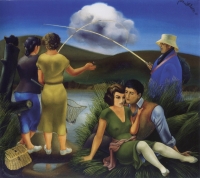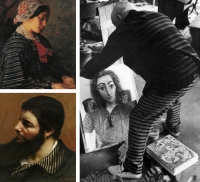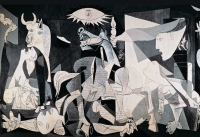18 May 2015
Still-lifes by Peale and Core [from the Archives]
Names are important in art. The American master Charles Willson Peale (1741-1827) had three sons who became painters: Rembrandt, Raphaelle [sic] and Titian. His fourth son was Rubens. Raphaelle is thought to be America’s first still-life painter
17 May 2015
Bread, art and metamorphosis
I just spent the past week learning how to bake bread properly, taught by an artisan baker. The effects were startling. Time passed unnoticed; the scraper became an extension of my body; and only by thinking of what it was like to be the dough d
26 Mar 2015
Ssh! The Secret of Picasso’s Ear
Ears make sense as one of the five: touch, taste, sight, sound and smell. But who thinks about Picasso's ears? We mostly remember his eyes: deep, dark and powerful. Yet he himself - as I don't think has been noted before - seems to have been very
05 Mar 2015
Picasso runs his fingers through her hair
No doubt in life Picasso did run his fingers through his girlfriend's hair. In the drawing (left) from 1906 he did so too, turning an image of Fernande into a representation of himself. He might have learnt the method from any number of artists
26 Feb 2015 | 2 Comments
Picasso on EPPH
At the small but excellent Museu Picasso in Barcelona, a repository for much of Picasso's early work and the complete series of paintings on Las Meninas, they sell a pencil (above). Draw your own conclusions. No comment.
11 Jan 2015
Hans Memling and Cubism
Every time I look at this Portrait of a Man by Hans Memling I feel a little sick. I’m serious. It makes me slightly nauseous. Perhaps Walter Pater, the 19th-century art historian, felt similarly about the Mona Lisa. He described her as a weirdo
17 Oct 2014
Brushing up on the Painter’s Sword
The mind of an artist is poetic so, if you want to understand painting and sculpture, read poets. Their literary metaphors are the artist’s visual ones. However, beware: poets understand visual art no better than most people. Emile Zola, Charl
24 Sep 2014 | 2 Comments
Reading Art: Manet, Picasso and Alfonso Ponce de Leon
My vision, like most people’s, is often cloudy which is why when the sun breaks and I gain some understanding, I get excited. You must excuse me. It may sometimes seem as if no-one before me has made similar observations. After all, all my ent
13 Mar 2014
Flat Noses on a Frontal Face
A year ago I used this early portrait drawing by Ingres (left) to demonstrate that Picasso's combination of faces from differing viewpoints, a hallmark of Cubism, was a technique practiced by earlier artists for a similar reason. Ingres, for ins
25 Feb 2014
Picasso-as-Courbet
Many great artists I follow use a feature other than the face to identify themselves in pictures that are not self-portraits. Given that all their figures represent the artist, they need a variety of methods to hide and reveal their self-referen
13 Jan 2014
Good Art is Not Original
There are some no-nos on EPPH to make conventional minds scream. No biography. Who cares how many women Picasso lived with? It makes no difference to the meaning of Guernica or even to images nominally depicting his loves. No historical or liter
20 Nov 2013
Picasso Hid a Sword in Nazi Loot
Sometimes I do no work at all. Things just pop in my face. I suppose I'm so used to looking for certain features that my eyes know what to look for subconsciously. That's what appeared to happen last week as I read the news that the Germans
10 Nov 2013 | 3 Comments
Why Art is So Similar
Some readers question whether the common themes of art explained here really exist because, in their minds, art is a product of individual expression. No wonder. That is what children are told and art lovers too. Picasso, for instance, is said t
29 Jan 2013 | 5 Comments
2nd Self-Portrait Found in Same Met Gallery!
After discovering a self-portrait by Picasso four days ago (see blog), I think I've discovered another one, this time by Bonnard.....hanging right opposite the other one at the Metropolitan Museum! The "coincidence" demonstrates, if nothing else
11 Dec 2012
Memory Holloway and Picasso
Memory Holloway, an art historian at the University of Dartmouth, Massachusetts, has written a wonderful book on a magnificent group of etchings by Pablo Picasso. It is titled Making Time: Picasso's Suite 347. Suite 347 is the name given to
17 Nov 2012
Mental images from Holbein, Ingres and Picasso
It is well-known that Picasso admired Ingres' portrait drawings like the one above on the left. Separately I have shown how Ingres, like other great masters, changed the facial features of his sitters to fuse them with his own. Not all portraits
16 Oct 2012
Picasso was Rembrandt
Under the theme 'Artist as Other Artist' I show how many painters and sculptors over the centuries have, in one way or another, adopted the persona of an earlier artist. The mask they then inhabit helps disguise their own role within the
23 Feb 2012
Faces in Our Minds
Humanity’s existence is so dependent on recognizing faces that our visual system specializes in it, reserving a large proportion of the brain’s neurons solely for that purpose. Amazingly we can even recognize a person in profile when we have
22 Dec 2011
Quiz: Can you see what Picasso’s up to?
OK, here's your chance to figure out a drawing before I give you my opinion. It's by the young Picasso of his girlfriend when they were on a summer vacation in the Spanish Pyrenees. It seems simple enough but nothing by Picasso is really
04 Dec 2011
Interpretation and Art
Gnosticism was a word coined in the seventeenth century to encompass those early Christian traditions that did not take Jesus’ words at face value and were often deemed heretical by the establishment Church. Many early Christians searched
23 Nov 2011
Rembrandt’s Hand
We have already seen (in Donatello’s Davids and Goliaths) that Donatello identified with both David and Goliath. Both his giants (in the marble and bronze versions) have double vision, out-sight and insight, the two forms conveyed by one eye o
16 Nov 2011
Picasso’s Visual Illusions In the Sculptor’s Studio
Some of Picasso's late etchings look as though they may have been tossed off without much thought. It's only when you can begin to study them closely that you realize how brilliant he was. In this print called In the Sculptor's Studi
30 Oct 2011 | 2 Comments
Cubism Explained
No-one, to my mind, has ever satisfactorily explained Cubism. Indeed I have found the explanations and their complexity totally confusing. Roland Penrose, a close friend of Picasso, claimed that Cubist images try:
‘to state t
20 Oct 2011
Picasso’s Eyeball
Yesterday I asked if anyone knew of a link between Manet’s Absinthe Drinker and Picasso’s Blue Period paintings. There are several. They both use Marcantonio Raimondi’s Portrait of Raphael, a small engraving, as their source; both were pai
19 Oct 2011
Find the link
What do you think links Manet's Absinthe Drinker to Picasso's Blue Period paintings?
Answer here.
09 Sep 2011
Murder and Butchery by Picasso and Chagall
A recent article on Chagal discusses his well-known identification with animals. It concludes with a drawing called The Butcher (top) which is so similar in meaning and method to Picasso’s The Murder (bottom), both drawn in the early 1930
12 Jul 2011
Introducing Bellini’s “Eyes”
I have recently introduced the argument that a significant number of compositions by Giovanni Bellini are not just representations of the apparent scene but, on another level, are representations of giant “heads”, “faces” or parts of fac
04 Jul 2011
Left Right, Open Closed: Eyes and Perception
I have explained under the theme Insight-Outsight how poetic painters often distinguish between two different modes of perception: outwards to see the exterior world of matter, inwards for insight into the soul and imagination. It is such a comm
30 May 2011
Metamorphic Form
Craig Tracy, a painter and former illustrator, creates arresting images (left) and then shows us how he did it (right). Few art historians realize that great masters, far more creative obviously than Tracy (no offense intended), often use the sa
06 May 2011
Picasso’s Ps
Remember to look for signatures on paintings because their careful placement can add meaning. It is rarely seen by those who are not artists themselves. Sometimes the artist's initial or initials are disguised as objects in nature so the vie
The EPPH Blog features issues and commentary.






























